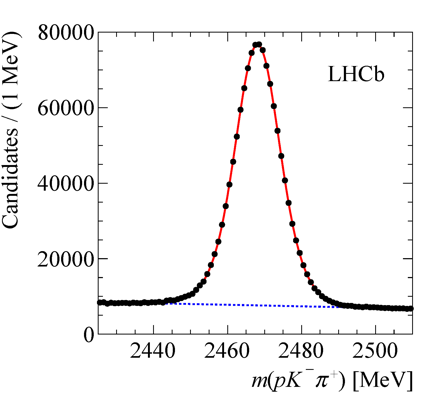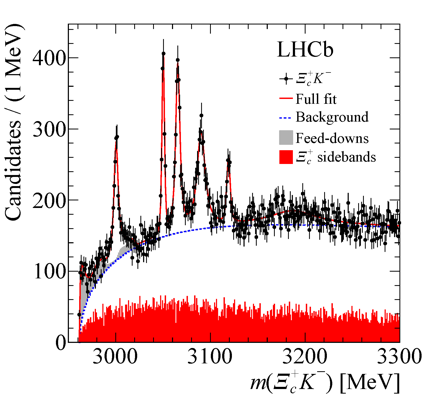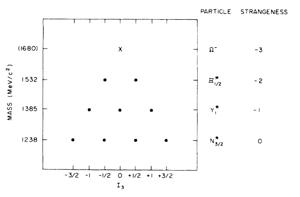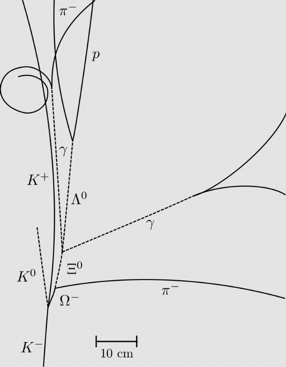Observation of five new narrow Ωc0 excited states.
As NASA announced a few days ago the discovery of the first system of seven Earth-size planets orbiting around a single star, so LHCb unveiled today the discovery of a new system of five particles, with the observation of five new narrow Ωc0 excited states.
LHCb physicists reconstructed a highly pure sample of charmed baryons Ξc+, with quark content csu, decaying into a proton p, a kaon K– and a pion π+. The p K–π+ invariant mass spectrum is shown in the left image below. The red peaking distribution shows the Ξc+ contribution above the background indicated by the blue dashed line.
Subsequently the Ξc+ candidates were combined with K– mesons present in the same event. The Ξc+ K– invariant mass distribution obtained in this way is shown in the right image above, revealing for the first time five narrow structures with an overwhelming statistical significance. These structures are interpreted as manifestations of excited states of the Ωc0 baryon. These excited states decay into a Ξc+ baryon and a K– meson via the strong interactions, in contrast to the weak decays responsible for the three particles used to form the Ξc+ mass peak.
The Ωc0 baryon is a higher mass partner of the Ω– baryon, a particle which played a very important role in the history of particle physics. In the 1950s many different particles were discovered. Initially thought to be elementary, the ever growing list of discoveries led physicists to doubt this assumption. Therefore efforts were made to find a classification scheme in analogy to the periodic table of chemical elements. The most successful such scheme was proposed by Gell-Mann. In this model mesons and spin 1⁄2 baryons are organized into octets (Eightfold Way) while spin 3⁄2 baryons form a decuplet, as displayed in the image on the left. When the scheme was proposed, the top-most particle in the image, the Ω–, was not yet discovered, but hypothesised to exist in order to complete the pattern. The regular structure of the decuplet enabled many properties of this new particle to be predicted, including its mass. The Ω– was subsequently discovered through a single famous bubble-chamber photograph obtained at the Brookhaven laboratory in 1964 (the corresponding line diagram is shown in the right picture). This picture validated the Eightfold Way, and led Gell-Mann to propose the quark model in 1964, which explains the structure of the octets and decuplet. In the quark model the Ω– is composed of three strange quarks (sss). The Ωc0 is like a Ω–, but contains a charm (c) quark in place of one of the strange quarks.
The ground state of the ssc system, the Ωc0 itself, has been known about for quite some time. The discoveries announced today are excited states of this system, analogous to the excited states of atoms. These states are named the Ωc(3000)0, Ωc(3050)0, Ωc(3066)0, Ωc(3090)0 and Ωc(3119)0, where the numbers indicate their masses in MeV as measured by LHCb. By discovering these particles LHCb has reinforced the exceptional role of the Ω baryon family in the history of particle physics.
Click the images for higher resolution. More details can be found in the LHCb publication. Read more in the CERN update for the public both in English and in French and also in the PRL Synopsis.




